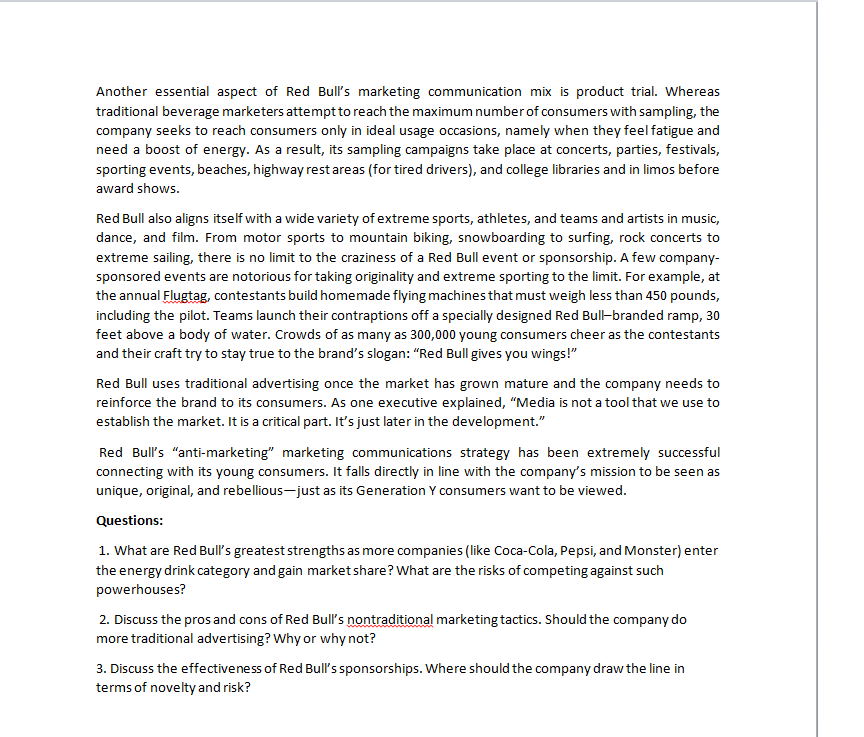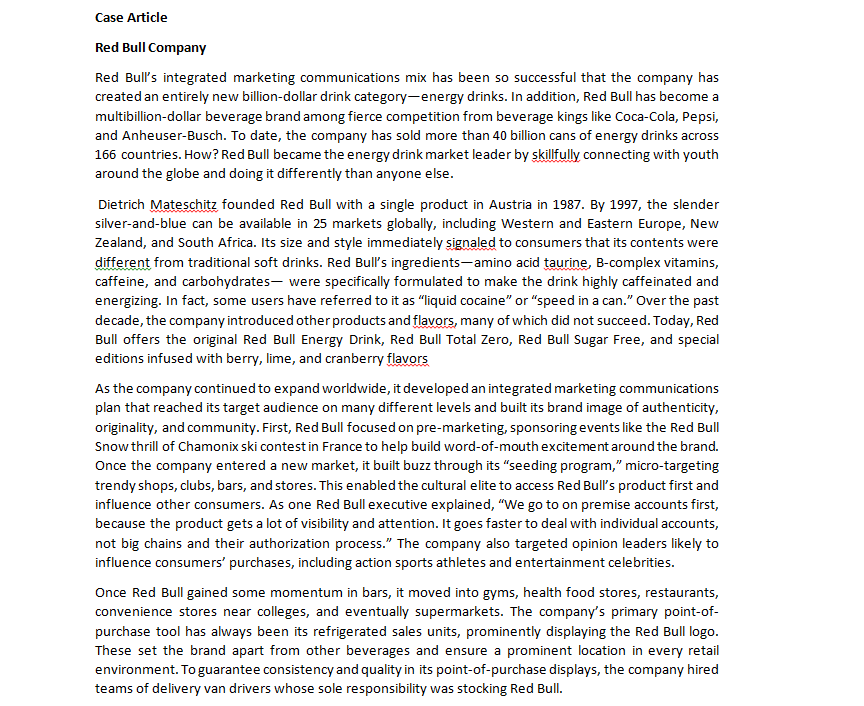Another essential aspect of Red Bull's marketing communication mix is product trial. Whereas traditional beverage marketers attempt to reach the maximum number of consumers with sampling, the company seeks to reach consumers only in ideal usage occasions, namely when they feel fatigue and need a boost of energy. As a result, its sampling campaigns take place at concerts, parties, festivals, sporting events, beaches, highway rest areas (for tired drivers), and college libraries and in limos before award shows. Red Bull also aligns itself with a wide variety of extreme sports, athletes, and teams and artists in music, dance, and film. From motor sports to mountain biking, snowboarding to surfing, rock concerts to extreme sailing, there is no limit to the craziness of a Red Bull event or sponsorship. A few company- sponsored events are notorious for taking originality and extreme sporting to the limit. For example, at the annual Flugtag, contestants build homemade flying machines that must weigh less than 450 pounds, including the pilot. Teams launch their contraptions off a specially designed Red Bull-branded ramp, 30 feet above a body of water. Crowds of as many as 300,000 young consumers cheer as the contestants and their craft try to stay true to the brand's slogan: "Red Bull gives you wings!" Red Bull uses traditional advertising once the market has grown mature and the company needs to reinforce the brand to its consumers. As one executive explained, "Media is not a tool that we use to establish the market. It is a critical part. It's just later in the development." Red Bull's "anti-marketing" marketing communications strategy has been extremely successful connecting with its young consumers. It falls directly in line with the company's mission to be seen as unique, original, and rebellious-just as its Generation Y consumers want to be viewed. Questions: 1. What are Red Bull's greatest strengths as more companies (like Coca-Cola, Pepsi, and Monster) enter the energy drink category and gain market share? What are the risks of competing against such powerhouses? 2. Discuss the pros and cons of Red Bull's nontraditional marketing tactics. Should the company do more traditional advertising? Why or why not? 3. Discuss the effectiveness of Red Bull's sponsorships. Where should the company draw the line in terms of novelty and risk?
Another essential aspect of Red Bull's marketing communication mix is product trial. Whereas traditional beverage marketers attempt to reach the maximum number of consumers with sampling, the company seeks to reach consumers only in ideal usage occasions, namely when they feel fatigue and need a boost of energy. As a result, its sampling campaigns take place at concerts, parties, festivals, sporting events, beaches, highway rest areas (for tired drivers), and college libraries and in limos before award shows. Red Bull also aligns itself with a wide variety of extreme sports, athletes, and teams and artists in music, dance, and film. From motor sports to mountain biking, snowboarding to surfing, rock concerts to extreme sailing, there is no limit to the craziness of a Red Bull event or sponsorship. A few company- sponsored events are notorious for taking originality and extreme sporting to the limit. For example, at the annual Flugtag, contestants build homemade flying machines that must weigh less than 450 pounds, including the pilot. Teams launch their contraptions off a specially designed Red Bull-branded ramp, 30 feet above a body of water. Crowds of as many as 300,000 young consumers cheer as the contestants and their craft try to stay true to the brand's slogan: "Red Bull gives you wings!" Red Bull uses traditional advertising once the market has grown mature and the company needs to reinforce the brand to its consumers. As one executive explained, "Media is not a tool that we use to establish the market. It is a critical part. It's just later in the development." Red Bull's "anti-marketing" marketing communications strategy has been extremely successful connecting with its young consumers. It falls directly in line with the company's mission to be seen as unique, original, and rebellious-just as its Generation Y consumers want to be viewed. Questions: 1. What are Red Bull's greatest strengths as more companies (like Coca-Cola, Pepsi, and Monster) enter the energy drink category and gain market share? What are the risks of competing against such powerhouses? 2. Discuss the pros and cons of Red Bull's nontraditional marketing tactics. Should the company do more traditional advertising? Why or why not? 3. Discuss the effectiveness of Red Bull's sponsorships. Where should the company draw the line in terms of novelty and risk?
Principles Of Marketing
17th Edition
ISBN:9780134492513
Author:Kotler, Philip, Armstrong, Gary (gary M.)
Publisher:Kotler, Philip, Armstrong, Gary (gary M.)
Chapter1: Marketing: Creating Customer Value And Engagement
Section: Chapter Questions
Problem 1.1DQ
Related questions
Question
can someone help me with my case article I've sent 2 pictures with the article and the questions thank you so much

Transcribed Image Text:Another essential aspect of Red Bull's marketing communication mix is product trial. Whereas
traditional beverage marketers attempt to reach the maximum number of consumers with sampling, the
company seeks to reach consumers only in ideal usage occasions, namely when they feel fatigue and
need a boost of energy. As a result, its sampling campaigns take place at concerts, parties, festivals,
sporting events, beaches, highway rest areas (for tired drivers), and college libraries and in limos before
award shows.
Red Bull also aligns itself with a wide variety of extreme sports, athletes, and teams and artists in music,
dance, and film. From motor sports to mountain biking, snowboarding to surfing, rock concerts to
extreme sailing, there is no limit to the craziness of a Red Bull event or sponsorship. A few company-
sponsored events are notorious for taking originality and extreme sporting to the limit. For example, at
the annual Flugtag, contestants build homemade flying machines that must weigh less than 450 pounds,
including the pilot. Teams launch their contraptions off a specially designed Red Bull-branded ramp, 30
feet above a body of water. Crowds of as many as 300,000 young consumers cheer as the contestants
and their craft try to stay true to the brand's slogan: "Red Bull gives you wings!"
Red Bull uses traditional advertising once the market has grown mature and the company needs to
reinforce the brand to its consumers. As one executive explained, "Media is not a tool that we use to
establish the market. It is a critical part. It's just later in the development."
Red Bull's "anti-marketing" marketing communications strategy has been extremely successful
connecting with its young consumers. It falls directly in line with the company's mission to be seen as
unique, original, and rebellious-just as its Generation Y consumers want to be viewed.
Questions:
1. What are Red Bull's greatest strengths as more companies (like Coca-Cola, Pepsi, and Monster) enter
the energy drink category and gain market share? What are the risks of competing against such
powerhouses?
2. Discuss the pros and cons of Red Bull's nontraditional marketing tactics. Should the company do
more traditional advertising? Why or why not?
3. Discuss the effectiveness of Red Bull's sponsorships. Where should the company draw the line in
terms of novelty and risk?

Transcribed Image Text:Case Article
Red Bull Company
Red Bull's integrated marketing communications mix has been so successful that the company has
created an entirely new billion-dollar drink category-energy drinks. In addition, Red Bull has become a
multibillion-dollar beverage brand among fierce competition from beverage kings like Coca-Cola, Pepsi,
and Anheuser-Busch. To date, the company has sold more than 40 billion cans of energy drinks across
166 countries. How? Red Bull became the energy drink market leader by skillfully connecting with youth
around the globe and doing it differently than anyone else.
Dietrich Mateschitz founded Red Bull with a single product in Austria in 1987. By 1997, the slender
silver-and-blue can be available in 25 markets globally, including Western and Eastern Europe, New
Zealand, and South Africa. Its size and style immediately signaled to consumers that its contents were
different from traditional soft drinks. Red Bull's ingredients-amino acid taurine, B-complex vitamins,
caffeine, and carbohydrates were specifically formulated to make the drink highly caffeinated and
energizing. In fact, some users have referred to it as "liquid cocaine" or "speed in a can." Over the past
decade, the company introduced other products and flavors, many of which did not succeed. Today, Red
Bull offers the original Red Bull Energy Drink, Red Bull Total Zero, Red Bull Sugar Free, and special
editions infused with berry, lime, and cranberry flavors
As the company continued to expand worldwide, it developed an integrated marketing communications
plan that reached its target audience on many different levels and built its brand image of authenticity,
originality, and community. First, Red Bull focused on pre-marketing, sponsoring events like the Red Bull
Snow thrill of Chamonix ski contest in France to help build word-of-mouth excitement around the brand.
Once the company entered a new market, it built buzz through its "seeding program," micro-targeting
trendy shops, clubs, bars, and stores. This enabled the cultural elite to access Red Bull's product first and
influence other consumers. As one Red Bull executive explained, "We go to on premise accounts first,
because the product gets a lot of visibility and attention. It goes faster to deal with individual accounts,
not big chains and their authorization process." The company also targeted opinion leaders likely to
influence consumers' purchases, including action sports athletes and entertainment celebrities.
Once Red Bull gained some momentum in bars, it moved into gyms, health food stores, restaurants,
convenience stores near colleges, and eventually supermarkets. The company's primary point-of-
purchase tool has always been its refrigerated sales units, prominently displaying the Red Bull logo.
These set the brand apart from other beverages and ensure a prominent location in every retail
environment. To guarantee consistency and quality in its point-of-purchase displays, the company hired
teams of delivery van drivers whose sole responsibility was stocking Red Bull.
Expert Solution
This question has been solved!
Explore an expertly crafted, step-by-step solution for a thorough understanding of key concepts.
This is a popular solution!
Trending now
This is a popular solution!
Step by step
Solved in 2 steps with 1 images

Recommended textbooks for you

Principles Of Marketing
Marketing
ISBN:
9780134492513
Author:
Kotler, Philip, Armstrong, Gary (gary M.)
Publisher:
Pearson Higher Education,

Marketing
Marketing
ISBN:
9781259924040
Author:
Roger A. Kerin, Steven W. Hartley
Publisher:
McGraw-Hill Education

Foundations of Business (MindTap Course List)
Marketing
ISBN:
9781337386920
Author:
William M. Pride, Robert J. Hughes, Jack R. Kapoor
Publisher:
Cengage Learning

Principles Of Marketing
Marketing
ISBN:
9780134492513
Author:
Kotler, Philip, Armstrong, Gary (gary M.)
Publisher:
Pearson Higher Education,

Marketing
Marketing
ISBN:
9781259924040
Author:
Roger A. Kerin, Steven W. Hartley
Publisher:
McGraw-Hill Education

Foundations of Business (MindTap Course List)
Marketing
ISBN:
9781337386920
Author:
William M. Pride, Robert J. Hughes, Jack R. Kapoor
Publisher:
Cengage Learning

Marketing: An Introduction (13th Edition)
Marketing
ISBN:
9780134149530
Author:
Gary Armstrong, Philip Kotler
Publisher:
PEARSON


Contemporary Marketing
Marketing
ISBN:
9780357033777
Author:
Louis E. Boone, David L. Kurtz
Publisher:
Cengage Learning